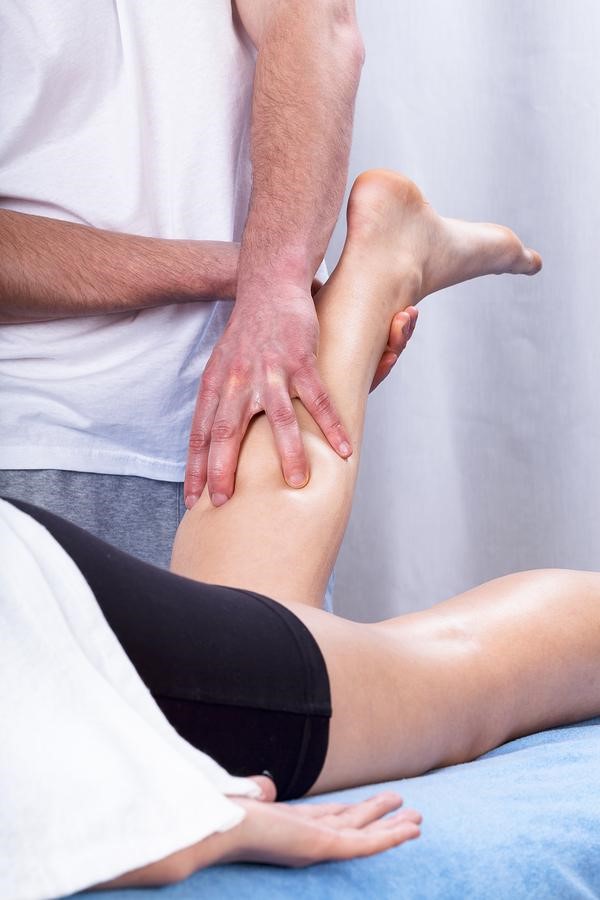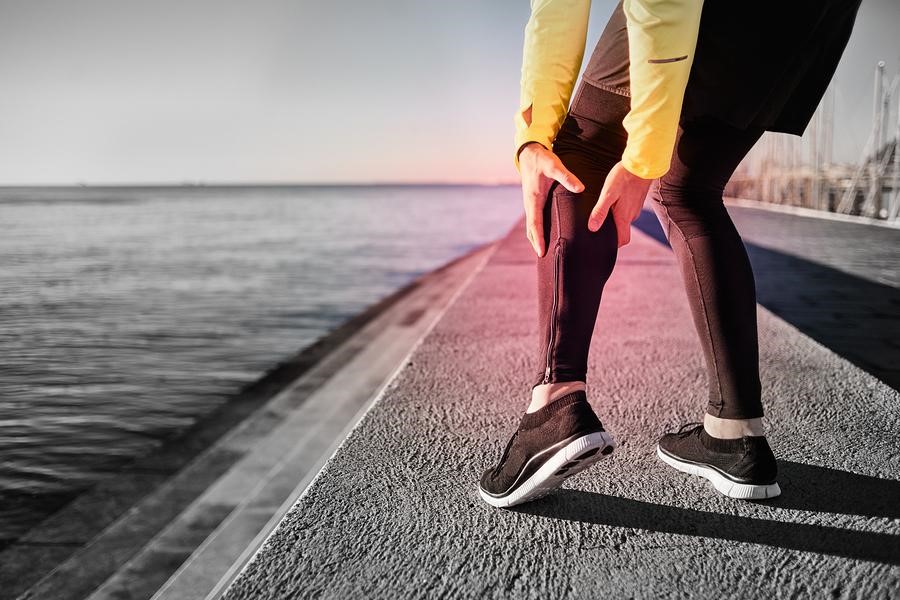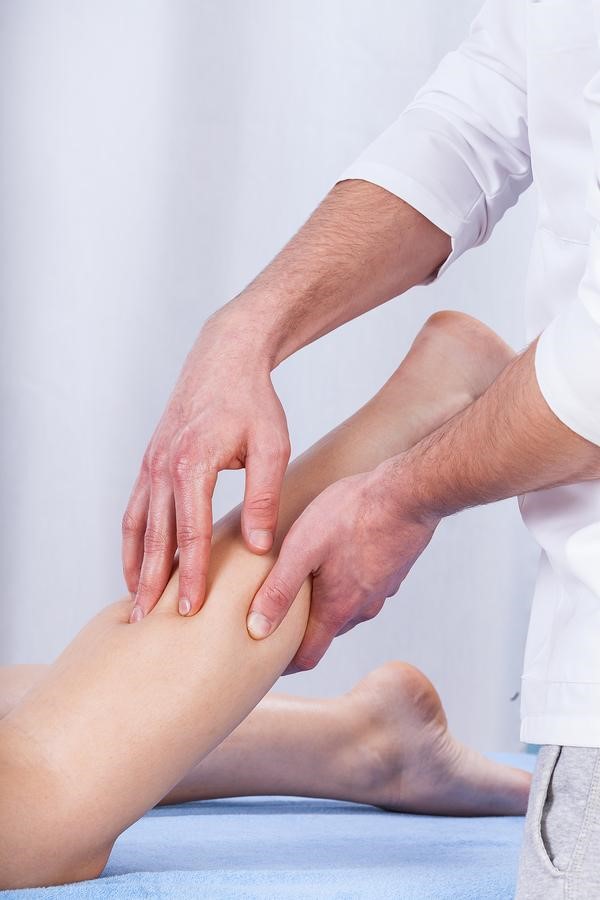The initial approach to physiotherapy of your calf strain will depend on how long after your injury that you seek treatment. The immediate line of defense straight after sustaining a calf strain should be the application of ice and compression, followed by rest and elevation. Recent research on the benefits of applying ice immediately after an injury are beginning to be questioned as it can halt the much-needed inflammatory response, but the general consensus is still to apply ice. Applying compression as a first line of defense is extremely important. This is generally done by wrapping the affected area. Recent evidence supports the critical role of compression in preventing secondary tissue damage.
The initial aim of treatment for acute calf strains at One Wellness is to decrease the pain as well as any secondary inflammation in the area. Some initial inflammation is required to start the healing process, but a large inflammatory response can also lead to secondary inflammation and secondary cell injury, which affects tissues that were not directly related to the initial insult. Ice and compression can greatly assist in decreasing this detrimental secondary tissue injury. Being that the swelling from a calf injury often ends up in the ankle or foot due to gravity pulling it downwards, elevating the ankle while there is still swelling can greatly assist in moving excess tissue fluid back towards your heart and out of your limb.
In cases where you are not dealing with an acute strain, heat may be more useful in decreasing pain. Your physiotherapist can advise you whether it is best to use ice or heat at your stage of healing. In the early phase your therapist may also use electrical modalities such as ultrasound or interferential current to help decrease the pain and control the amount of inflammation. Again, in the initial healing stages all anti-inflammatory attempts are aimed at controlling too much inflammation from occurring, rather than completely eliminating it. Inflammation that remains after the initial phases of healing, however, is undesired, so by this stage of healing, the aim is to finally eliminate any remaining swelling. Massage of the injured area or the tissues surrounding the area may be helpful in both decreasing swelling and decreasing pain. Depending on the severity of the strain and the time that has elapsed since the injury, massage directly over the torn calf muscle can slow the healing process and may lead to other muscle complications so be sure to heed your physiotherapist’s advice on whether or not this is something you should be doing on your own.
As indicated above, medication to ease the pain or inflammation can often be very beneficial in the overall treatment of a calf strain. Depending on the degree of your strain and stage of healing, your physiotherapist may suggest you see your doctor to discuss the use of anti-inflammatory or pain-relieving medications in conjunction with your physiotherapy treatment. Your physiotherapist may even liaise directly with your doctor to obtain their advice on the use of medication in your individual case.
Once the initial pain and inflammation has calmed down, your physiotherapist will focus on improving the range of motion and strength of your calf. Static stretches to increase the movement of your calf muscle will be prescribed by your physiotherapist early on in your treatment. These types of stretches encourage the healing tissues to withstand stretch and they ensure that you do not lose any range of motion. As your range of motion improves, more aggressive stretches will be added, however stretching should be limited such that it never causes pain. Feeling a gentle stretch at the end of the range of motion should be the limit otherwise further damage could occur to the calf muscle. As the muscle advances in the healing process, dynamic stretching (rapid motions that stretch the tissues quickly) will also be taught and will be incorporated into your rehabilitation exercise routine in order to prepare your calf to return to more taxing movements such as prolonged walking, stair climbing, and jumping. Dynamic stretches are used to prepare the tissues for activity whereas static stretches focus more on gaining flexibility.
Rest is also an important part of your physiotherapy treatment. ‘Relative rest’ is a term used to describe a scale of resting compared to the normal activity you would be doing. If you are experiencing pain while doing nothing at all it means the injury is more severe and your physiotherapist may advise a period of complete rest where you do either no activity, or just do light activity such as a few gentle stretches. As your pain improves then the rest to activity balance will swing the other way such that you will still require more rest for the calf than usual, but there will also be a gradual increase in activity including more aggressive stretches along with strengthening as long as there is no return in symptoms.
 Along with stretching exercises, your physiotherapist will also prescribe strengthening exercises in order to get your calf back in top shape. Initially your therapist may suggest that you only do isometric contractions of your muscle, which means that you tighten the affected muscle without actually moving the associated joints. An example of this type of contraction may be sitting with your foot flat against a wall, and pushing into the wall without actually moving your ankle. This type of contraction is an effective way to begin strengthening your calf. As the muscle continues to heal, more aggressive strengthening will be prescribed where you are raising up onto your toes with part or all of your body weight. When appropriate your therapist will prescribe strengthening exercises with free weights, elastic bands or tubing, weight machines, or cardiovascular machines such as stationary bicycles or a treadmill in order to continue to increase the strength and endurance in your calf. As your calf is more fully healed, your therapist will add eccentric type strengthening to your rehabilitation program. Eccentric exercises are ones that put load through your muscle as it is lengthening. These types of exercises are necessary as part of your rehabilitation program in order to prepare your calf for the return to normal everyday activity and sport. Lowering yourself off the end of a step or landing from jumping are examples of eccentric exercises for your calf. Quite often it is an eccentric contraction of the muscle that has caused the calf strain in the first place, so training the muscle (when the time is right) to withstand this type of force is crucial to ensuring it won’t be re-injured. Plyometrics is a form of power strengthening that is a particularly important part of the end stage of your rehabilitation for a calf strain, especially if you are involved in sport. Plyometrics involves repetitive jumping which forces your calf muscle to engage in force as it repetitively shortens and lengthens. This type of training maximally loads the calf muscle.
Along with stretching exercises, your physiotherapist will also prescribe strengthening exercises in order to get your calf back in top shape. Initially your therapist may suggest that you only do isometric contractions of your muscle, which means that you tighten the affected muscle without actually moving the associated joints. An example of this type of contraction may be sitting with your foot flat against a wall, and pushing into the wall without actually moving your ankle. This type of contraction is an effective way to begin strengthening your calf. As the muscle continues to heal, more aggressive strengthening will be prescribed where you are raising up onto your toes with part or all of your body weight. When appropriate your therapist will prescribe strengthening exercises with free weights, elastic bands or tubing, weight machines, or cardiovascular machines such as stationary bicycles or a treadmill in order to continue to increase the strength and endurance in your calf. As your calf is more fully healed, your therapist will add eccentric type strengthening to your rehabilitation program. Eccentric exercises are ones that put load through your muscle as it is lengthening. These types of exercises are necessary as part of your rehabilitation program in order to prepare your calf for the return to normal everyday activity and sport. Lowering yourself off the end of a step or landing from jumping are examples of eccentric exercises for your calf. Quite often it is an eccentric contraction of the muscle that has caused the calf strain in the first place, so training the muscle (when the time is right) to withstand this type of force is crucial to ensuring it won’t be re-injured. Plyometrics is a form of power strengthening that is a particularly important part of the end stage of your rehabilitation for a calf strain, especially if you are involved in sport. Plyometrics involves repetitive jumping which forces your calf muscle to engage in force as it repetitively shortens and lengthens. This type of training maximally loads the calf muscle.
In addition to stretching and strengthening the muscle, taping, wrapping or using a soft support/brace on the calf may be suggested by your physiotherapist in order to assist initial swelling, and to provide support to the muscle as you rehabilitate it. They may even teach you how to tape or wrap your own muscle so you can do it on your own.
A critical part of our treatment for a calf strain at One Wellness includes advice on finally returning to your full normal physical activity level. A calf strain can easily be aggravated if too much stress is put through it at an inappropriate time. Calf strains can easily be re-aggravated. Returning to your normal physical activity at a graduated pace is key in avoiding a repetitive calf strain. Advice from your physiotherapist on the acceptable level of activity at each stage of your rehabilitation process will be invaluable, and will assist you in returning to your activities as quickly but as safely as possible.


 After a thorough history your physiotherapist will do a physical examination. They will examine the area to determine if there is any swelling or bruising present and will palpate (feel) your calf to find out which area is most sore. Your therapist will also check to see if there are any divots or unusual bumps in the calf area, which are usually the result of a section of torn muscle fibers and would indicate a more severe strain. They will also closely exam the appearance of your Achilles tendon and how it moves as you (or they) contract or squeeze your muscle. It is important to rule out tearing of the Achilles tendon, which can appear very similar to a calf strain in the initial stages. Your therapist will ask you to contract your muscle and move your knee and ankle joints in order to determine how much range of motion you have and whether or not moving your foot causes calf pain.
After a thorough history your physiotherapist will do a physical examination. They will examine the area to determine if there is any swelling or bruising present and will palpate (feel) your calf to find out which area is most sore. Your therapist will also check to see if there are any divots or unusual bumps in the calf area, which are usually the result of a section of torn muscle fibers and would indicate a more severe strain. They will also closely exam the appearance of your Achilles tendon and how it moves as you (or they) contract or squeeze your muscle. It is important to rule out tearing of the Achilles tendon, which can appear very similar to a calf strain in the initial stages. Your therapist will ask you to contract your muscle and move your knee and ankle joints in order to determine how much range of motion you have and whether or not moving your foot causes calf pain.  Along with stretching exercises, your physiotherapist will also prescribe strengthening exercises in order to get your calf back in top shape. Initially your therapist may suggest that you only do isometric contractions of your muscle, which means that you tighten the affected muscle without actually moving the associated joints. An example of this type of contraction may be sitting with your foot flat against a wall, and pushing into the wall without actually moving your ankle. This type of contraction is an effective way to begin strengthening your calf. As the muscle continues to heal, more aggressive strengthening will be prescribed where you are raising up onto your toes with part or all of your body weight. When appropriate your therapist will prescribe strengthening exercises with free weights, elastic bands or tubing, weight machines, or cardiovascular machines such as stationary bicycles or a treadmill in order to continue to increase the strength and endurance in your calf. As your calf is more fully healed, your therapist will add eccentric type strengthening to your rehabilitation program. Eccentric exercises are ones that put load through your muscle as it is lengthening. These types of exercises are necessary as part of your rehabilitation program in order to prepare your calf for the return to normal everyday activity and sport. Lowering yourself off the end of a step or landing from jumping are examples of eccentric exercises for your calf. Quite often it is an eccentric contraction of the muscle that has caused the calf strain in the first place, so training the muscle (when the time is right) to withstand this type of force is crucial to ensuring it won’t be re-injured. Plyometrics is a form of power strengthening that is a particularly important part of the end stage of your rehabilitation for a calf strain, especially if you are involved in sport. Plyometrics involves repetitive jumping which forces your calf muscle to engage in force as it repetitively shortens and lengthens. This type of training maximally loads the calf muscle.
Along with stretching exercises, your physiotherapist will also prescribe strengthening exercises in order to get your calf back in top shape. Initially your therapist may suggest that you only do isometric contractions of your muscle, which means that you tighten the affected muscle without actually moving the associated joints. An example of this type of contraction may be sitting with your foot flat against a wall, and pushing into the wall without actually moving your ankle. This type of contraction is an effective way to begin strengthening your calf. As the muscle continues to heal, more aggressive strengthening will be prescribed where you are raising up onto your toes with part or all of your body weight. When appropriate your therapist will prescribe strengthening exercises with free weights, elastic bands or tubing, weight machines, or cardiovascular machines such as stationary bicycles or a treadmill in order to continue to increase the strength and endurance in your calf. As your calf is more fully healed, your therapist will add eccentric type strengthening to your rehabilitation program. Eccentric exercises are ones that put load through your muscle as it is lengthening. These types of exercises are necessary as part of your rehabilitation program in order to prepare your calf for the return to normal everyday activity and sport. Lowering yourself off the end of a step or landing from jumping are examples of eccentric exercises for your calf. Quite often it is an eccentric contraction of the muscle that has caused the calf strain in the first place, so training the muscle (when the time is right) to withstand this type of force is crucial to ensuring it won’t be re-injured. Plyometrics is a form of power strengthening that is a particularly important part of the end stage of your rehabilitation for a calf strain, especially if you are involved in sport. Plyometrics involves repetitive jumping which forces your calf muscle to engage in force as it repetitively shortens and lengthens. This type of training maximally loads the calf muscle.


 (403) 679-7179
(403) 679-7179  concierge@one-wellness.ca
concierge@one-wellness.ca 

